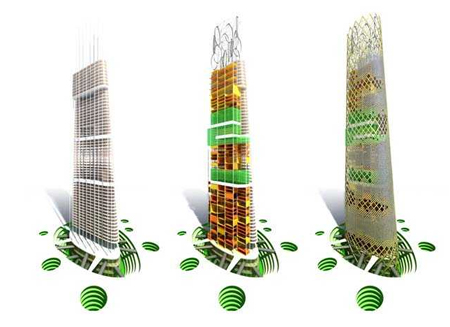Winner of the 2004 ‘Eco Boulevard‘ competition held by the Madrid Municipal Housing Corporations Residential Innovation Office [that's a mouthful], Urban Ecosystems’ ‘Air Tree‘ project consists of 3 pavilions situated within a 500 meter by 50 meter boulevard.

Designed as the initial ‘attraction’ for the site, the pavilions have been conceptualized as a ‘prosthesis’ – around which social interaction/revitalization, plant life, and future spaces can grow. The structures are therefore temporary – acting merely as a magnet to draw new life to the site. The boulevard will be gradually filled with trees and plant-life, until such a time when ‘air-conditioned spaces are no longer needed, when the area becomes fixed’. The pavilions will then be dismantled – leaving behind a void in the new growth [images above].

A light, easily assembled/dismantled [and recyclable!] structure, the ‘Air Tree‘ is energy self-sufficient – using only the power it can capture through a number of photovoltaic panels. Any energy not used by the pavilions themselves is sold back to the grid, the proceeds from which go to maintain this new urban park.

While the boulevard will eventually grow into a park – these ‘Air Trees‘ will work to do the same job as the trees will in the future. Along with providing a defined, shaded place to congregate [like the base of a tree], the pavilions will actually condition the air. Within the metallic screen/skin of the ‘Air Trees‘ is a layer of plantings – small trees running around the perimeter of the pavilions.
…[there are] simple air conditioning systems installed in the air tree. They are evapotranspirators. This is a natural way to air condition a space, not a part of commercial strategy. Rather, it creates naturally conditioned spaces between 8-10°C cooler than the surrounding streets where the residents can take active part in the public domain [via].

And oh yeah – they look pretty ill too. They should build some of these bad-boys here in the Bean, on that no-man’s-land the Big Dig has left us…
::For more interesting/provocative ‘green‘ projects, visit ecosistema urbano – additional information for this post via Greenline::












